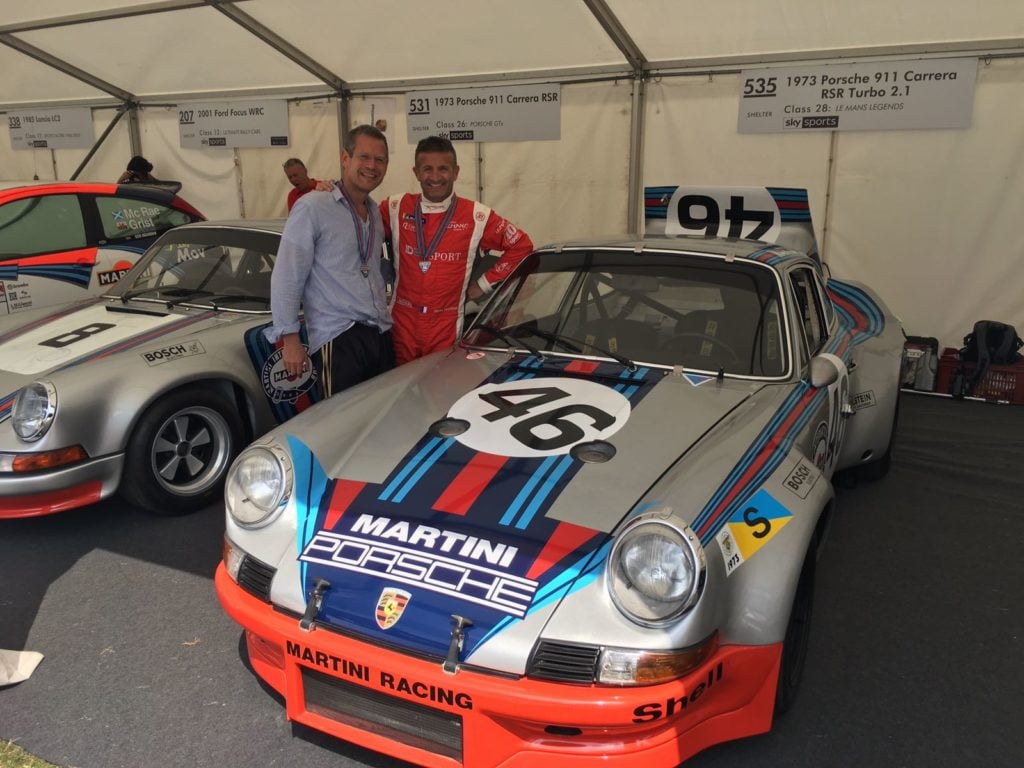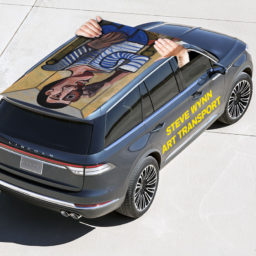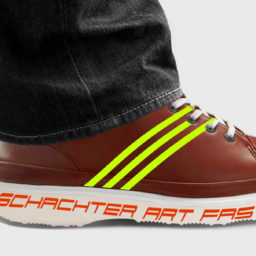As an isolated, overweight child growing up in Long Island with zero exposure to culture, cars were my gateway drug to art. It was the industrial design that initially drew me in, and now I when I sit down to write I have a car directly under my desk, in my office that was once a garage and which I have since converted into a hybrid office-cum-carpark. The reasoning: when you drive a vehicle you don’t see it, and when you park, you leave it. I am drawn to the lines, smells, and furniture (aka car seats), all of it. I love to look at cars, except when I write about art—then I black out, see nothing but the page, and listen to the same song 200 times in a row. (The Strokes recently, ugh.)
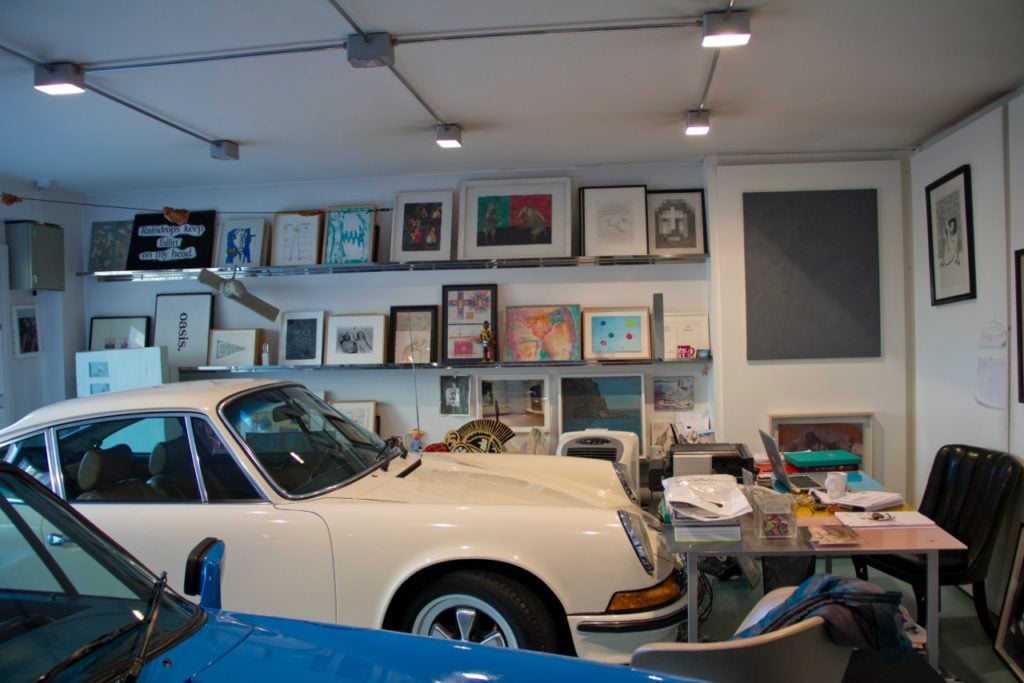
Office work: garage converted to office, converted to garage. Photo by Kenny Schachter.
Goodwood House, in Chichester, West Sussex, was built in 1600 and acquired by the Duke of Richmond in 1697; the 12,000-acre estate features car and horse racetracks, an airport, two golf courses, a hotel, and an organic farm. (I wandered into a pig patch and got challenged by a 300-pound beast.) The headquarters of Rolls Royce are also situated on the premises. There are George Stubbs hunting scenes, a Caneletto London-scape, Van Dycks, and a Veronese on the walls, lest I forget. The present Duke, Charles Richmond, established the Festival of Speed (FOS) 25 years ago, a hillclimbing event where competitors race against the clock on a vertiginous course—in this case, the service road in front of the Duke’s pile (UK slang for a rather large abode). Five years later he launched the Revival, where visitors dress in period attire to embrace the early days of motorsport.
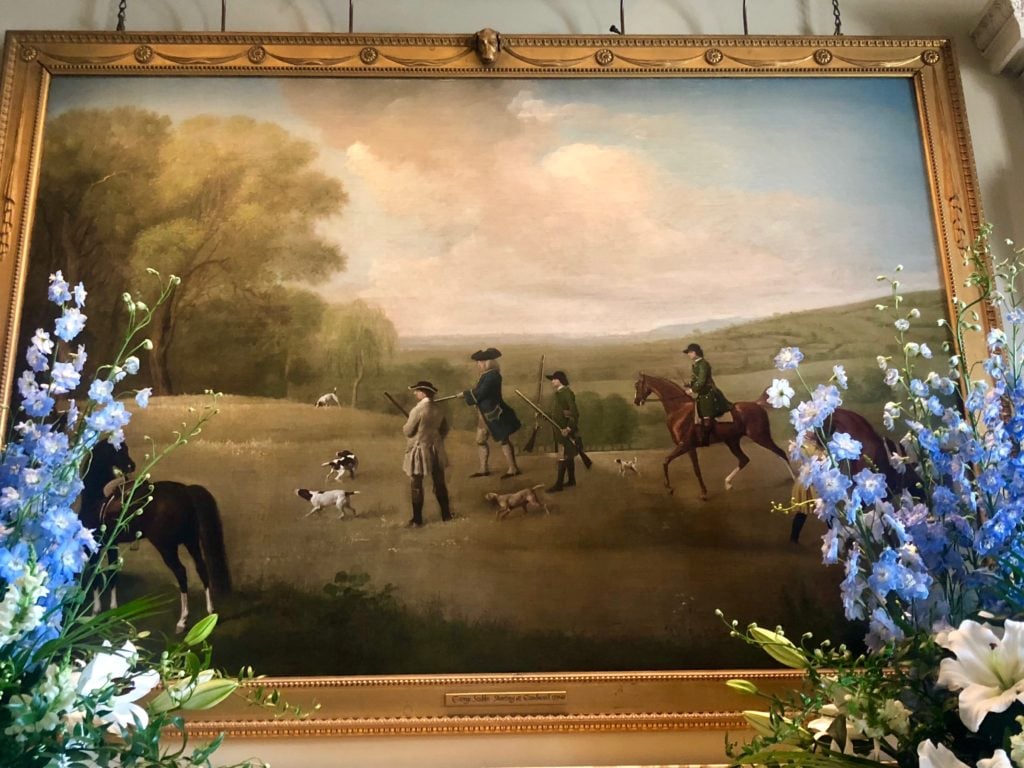
A George Stubbs painting, one of three hanging in Goodwood House, temporarily obscured by a beautiful flower arrangement for the event. There is also a Canaletto in the Long Hall. Photo by Kenny Schachter.
The FOS went from employing 80 at its inception to more than 700 now, with visitors numbers reaching in excess of 300,000 over the weekend. There was a sit-down dinner for 1,600-plus. Revenues from Charles Richmond’s activities generated £86.7 million last year and bring more than £100 million to the area. I’ve never seen a comparable study about the economic spillover of art fairs, but I’d gather it’s as substantial in cities like Miami, Basel, London, and New York. The Duke is a brilliant, elegant entrepreneur who took a beating upside his head in 2016 when intruders broke into the estate and made off with centuries of priceless heirlooms—as if the racing wasn’t dangerous enough. (And it is: fatalities and life changing injuries are not unheard of.)
In addition to the 25th anniversary of the FOS were celebrations to mark 70 years of Porsche, 50 years of Martini-sponsored racing, and a few other corporate milestones—you could say participants were in congratulatory mood (or at least the marketers were). Nothing is ostensibly for sale other than heaps of organic meats—the fate of the angry pig that challenged me in the field, no doubt—plus racing paraphernalia and plentiful booze that spectators drink from morning onward like they’re at the airport off to a boisterous holiday. The woozy atmosphere doesn’t stop the automotive manufacturers from splashing out millions on extravagant pavilions that look anything but temporary (which they are). To put it into perspective, the art market grosses anywhere from $40 billion to $60 billion a year, while Volkswagen alone boasts yearly revenue of around $300 billion.
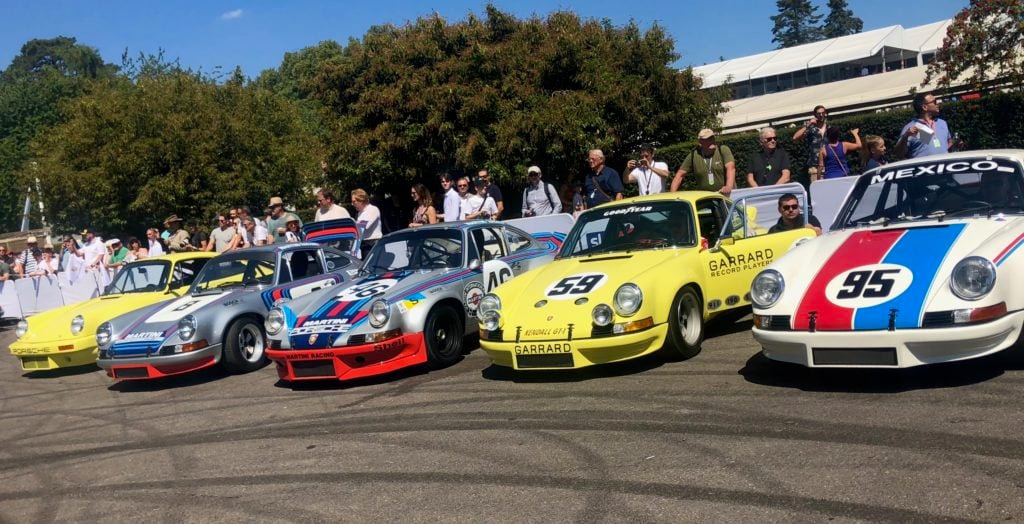
1973 was a very good year, indeed. Photo by Kenny Schachter.
People (like me) often complain that the art world is cutthroat, and a minefield for the unwary. The classic car market is worse, by a factor of a zillion. As soon as something attains value, the criminal element seemingly come out of the woodwork in search of the next dupe. And with a Ferrari 250 GTO, one of 39 iterations produced from 1962-64, fetching $70 million in a private sale last month—and with another coming to auction at the end of August at RM Sotheby’s (with expectation in excess of $45 million)—there are no shortages of nefarious profiteers. You could surely make an algorithm for art and car crime in relation to escalating values—not to mention that the politics swirling around the automotive market are as stifling as any art-fair selection committee.
Trust me, I know firsthand: I have experienced no less than three occasions where people have made unwarranted accusations contesting the authenticity of perfectly valid cars I have collected, including an anonymous email calling a Porsche I own an outright fake. Once, when I returned from a ski trip with a foot injury, both me and one of my cars were subjected to MRI tests on the same day—my foot to determine if any bones were broken, my car to ascertain if anyone had forged serial numbers inscribed into the chassis.
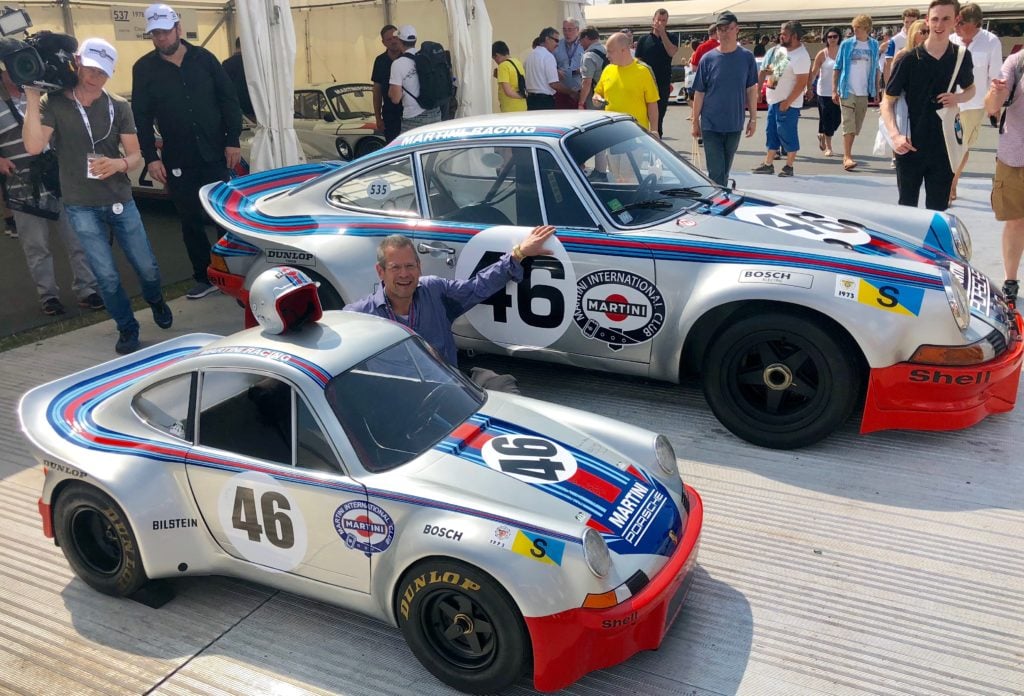
A mini-me next to my mechanic’s Little Le Mans entrant, hand crafted from scratch. Photo courtesy of Kenny Schachter.
One facsimile I didn’t object to was the miniature version of my 1973 Porsche factory prototype RSR (which the Duke had invited to participate in this year’s hillclimb) that came in fourth place at Le Mans the year of its manufacture. The scaled-down copy was built by my mechanic Stuart Gurr for his daughter Scarlett to drive in the Little Big Mans race, which takes place for drivers aged 7-12 every year before the Classic Le Mans in France, and which requires no seatbelts or helmets to participate—an American ambulance-chaser’s dream.
Driving an old car is like the Joad family’s journey across the US in John Steinbeck’s The Grapes of Wrath. Economic necessity, i.e. poverty, forced the Joads to acutely monitor the reliability of their truck in their search for gainful employment, their lives literally depending on it. The smells and sounds of an engine take on new meaning, activating all the senses, when you’re uncertain whether or not you’ll reach your destination. Such is the life of a classic car fanatic, too… like when I set off to Goodwood in my 1977 Volkswagen Golf GTI Mk 1 and, two miles away from the FOS, my clutch blew and the car came to a juddering halt. That was fairly embarrassing but not uncommon en route to an old car event, where casualties mount on the roadside with increasing frequency as you near the grounds of the estate. It was a fitting way to celebrate July’s Friday the 13th.
I worry that in the days of ride-sharing and short attention spans, subsequent generations will lose the taste for such adventures, which would be a shame as these enthusiasms preserve an historically important aspect of culture and industrial design. Will cars become extinct, studied in the form of fossils? God save the car! As it happens, I wasn’t stranded on the side of the road for long, because an old acquaintance I hadn’t seen for 10 years, and who was now dealing in cars, happened to pass me on the street and gave me a lift to Goodwood. On the way, he tried to sell me a car or two, slagging off his competitors and spilling the beans on clients, some of whom I knew. Not too dissimilar from the art world.
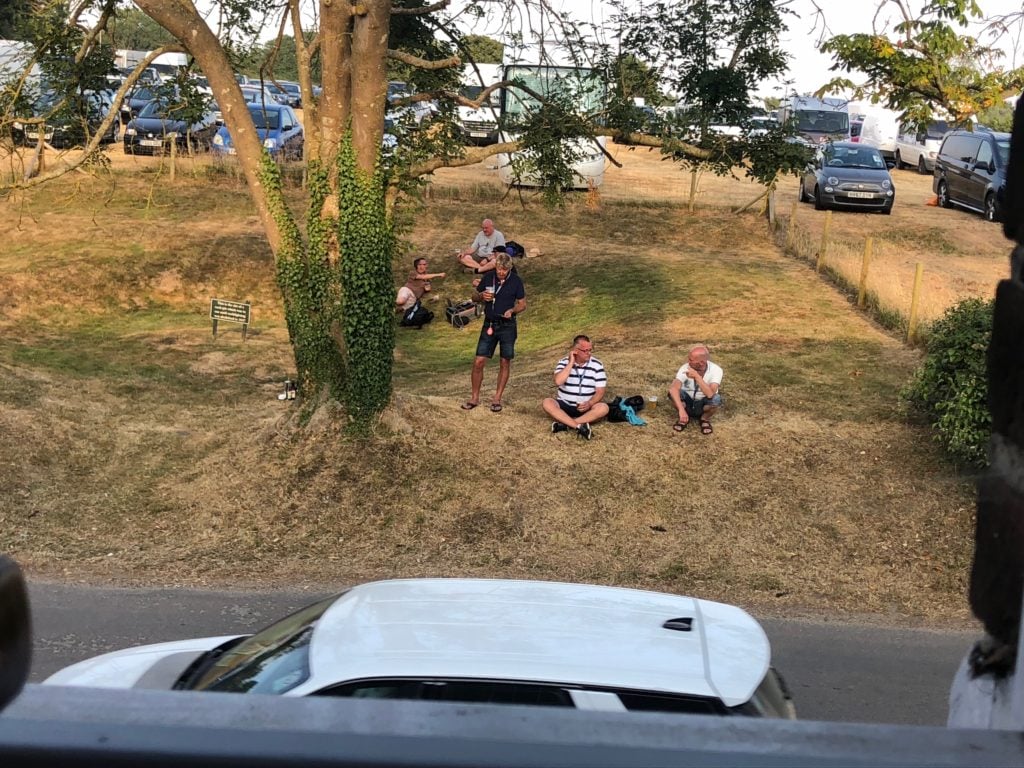
(Hotel) room with a view: the sign reads that this was the site of a cockfight pit before the sport was banned in 1847. Now its a beer pit. Photo by Kenny Schachter.
The 7 am wakeup call at the Goodwood Hotel, host to sundry F1 drivers past and present, comes by way of the violent howl of revving race engines reverberating at the top of the hill, only a few hundred yards from the rooms. You will find many period drivers still at it decades after their heydays, driving on behalf of owners either too preoccupied or ill equipped (like me) to pilot such magnificent, valuable, and treacherous machinery. Legendary racers, some of near-mythological status, such as Mario Andretti (b. 1940), Richard Petty (b. 1937), Derek Bell (b. 1941), Hurley Haywood (b. 1948), and Gijs van Lennep (b. 1942)—the latter two of which both drove my car in 1973—where on hand. Nic Mason (b. 1944), who you might recall as Pink Floyd’s drummer, regularly races his $70 million Ferrari 250 GTO at Goodwood and elsewhere, and this year was no different.
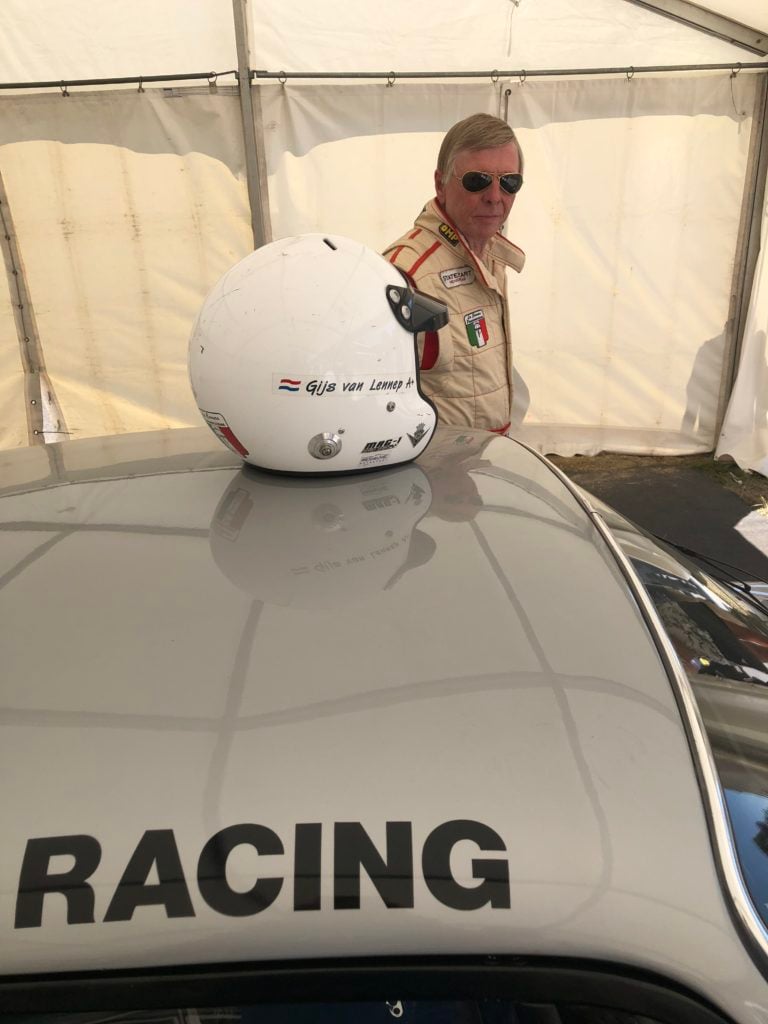
Gijs van Lennep (b. 1942): former lawyer, a Dutch nobleman, and more importantly, three-time winner of Le Mans in the 1970s for Porsche. Also, still looking pretty damn cool. Photo by Kenny Schachter.
Some of them probably couldn’t qualify for a road license nowadays, but what other sport can you be competitive, fast, and furious well into your seventh decade? And publicly embraced! It’s not uncommon for fans to approach such fabled drivers with stacks of photos to sign (to sell on eBay, I’d gather), which the graying heroes do without the slightest protest. In fact, most everyone is as kind and nonhierarchical, there’s a community spirt thick in the air.
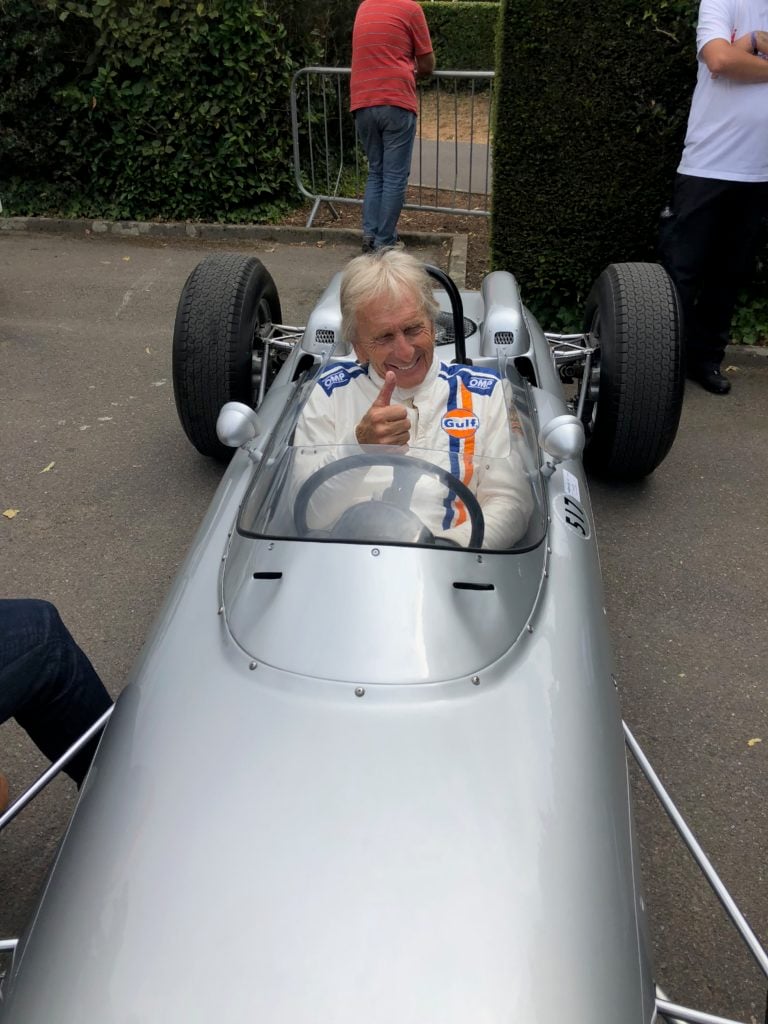
Derek Bell (b. 1941) five-time Le Mans winner, three-time Daytona 24 winner, and two-time winner of the World Sportscar Championship—and he’s still at it. Fabulously incorrigible. Photo by Kenny Schachter.
Speaking of old guys, Adam Lindemann (b. 1961, like me), just ran the (non-kids) Classic Le Mans after rolling his 1960s Mustang in a racing accident a few short months ago; hat’s off, and be careful Adam. I was hankering to drive up the hill myself but couldn’t really afford to f it up. Besides, when I walk it’s life-threatening. (I actually had a racing license some years ago but was too chicken to ever employ it on a track.) When a car crashed last week, the commentator remarked: “There is no runoff”—the safe area beside the track should cars lose control—”which makes this event old-school and so special!” Nothing like a little bit of life or death danger to get the blood flowing. No one ever died dealing art… yet. Although, there was an Oxford-based bookseller murdered in 2016 over a first edition of The Wind in the Willows, the children’s novel by Kenneth Grahame published in 1908. Whoever said people aren’t passionate about books anymore? Sorry.
Cars spinning in circles, racing up and down a hill for 10 hours a day, smoke billowing from tires, Royal Air Force planes performing overhead amidst a sea of cheering fans—it all amounts to a veritable pollution fest, but it’s short-lived and infrequent. Though some electric vehicles raced the hill, I suggest they are far worse for the environment—just consider a microcar with a small engine versus the 1,200 pounds of lead batteries and 250 pounds of plastic that go into each Tesla. An all-electric VW won the outright hillclimb competition this year anyway, amends for their emissions mishap, I guess. But, as F1 driver Sebastian Vettel said, batteries are for phones, not cars. There’s something to be said for the ferocious, eardrum-splitting sound of fossil fuel combusting, with cars screeching like cats being murdered. (I love cats, by the way.) It’s music, albeit of the head-banging variety.
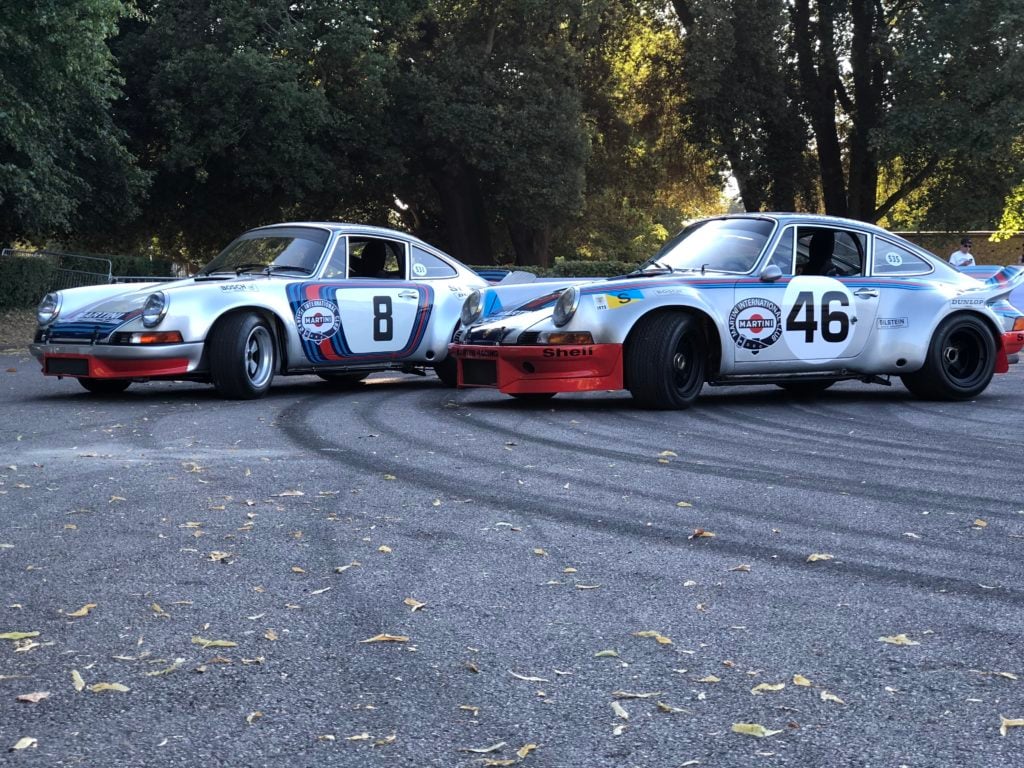
R6 and R7 RSR factory prototypes—the only survivors remaining—reunited for first time since 1973. Photo by Kenny Schachter.
The FOS was largely international in turnout this year, but only about 10 percent non-white, with little if any Asian presence. There were a smattering of female drivers, though more would be better. Regarding the Chinese, with no racing culture past or present (unlike Japan), it’s doubtful they will develop one anytime soon, especially in light of the fact that it’s illegal to drive a car in China that’s more than 10 years old. Car people are as passionate as art folk and friendlier (generally), though more likely to try and steal from you. I half expected Hans Ulrich Obrist to pop up in a racing suit emblazoned with a Serpentine logo. In fact, why doesn’t Larry G., a noted classic-car collector, sponsor a team? I’ll happily manage it.
